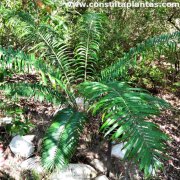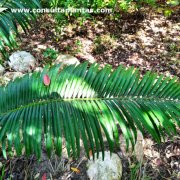Care of the cycad Encephalartos villosus or Poor man's cycad |
|
The genus Encephalartos, family Zamiaceae, comprises 60 species of cycads native to Africa. Some species are: Encephalartos villosus, Encephalartos senticosus, Encephalartos natalensis, Encephalartos lebomboensis, Encephalartos horridus, Encephalartos ferox, Encephalartos altensteinii, Encephalartos lehmannii, Encephalartos transvenosus, Encephalartos aemulans, Encephalartos paucidentatus. Common name: Poor man's cycad. This species is native to South Africa. They are fast-growing plants that have an underground trunk that reaches 30 cm (11.8") in height. The arched leaves are up to 3 meters (9.84 feet) in length and are glossy dark green. They produce male and female cones (they are dioecious plants). Poor man's cycad is used in undergrowth or in cool areas of the garden in small groups of 2-3 plants and as isolated specimens. It combines well with plants of the genus Plectranthus. They are also grown in pots for patios and terraces. Encephalartos villosus prefers a shaded or semi-shaded exposure avoiding the sun's rays in the central hours of the day. It resists frosts down to -5 ºC (23 ºF) but the leaves burn; it is better that the temperature is not lower than 5 ºC (41 ºF). It's an ideal plant for subtropical and warm climates. The soil should be very well drained and contain plenty of compost. The pot transplant is done in early spring. Water regularly throughout the year waiting for the substrate surface to dry; it needs the soil to be always slightly moist (never waterlogging). Prune wilted leaves in early spring. Encephalartos villosus is a plant resistant to pests and diseases. Poor man's cycad propagates by seeds sown in spring but take several months to germinate. |
Images of the cycad Encephalartos villosus or Poor man's cycad |
Find plants
Encephalartos villosus or Poor man's cycad | Care and Growing
© 2025 FavThemes


